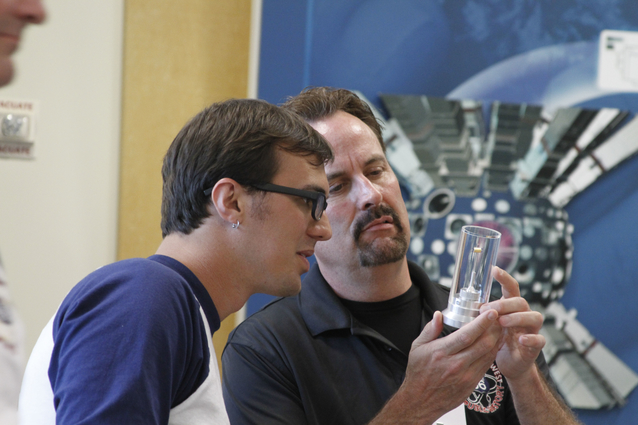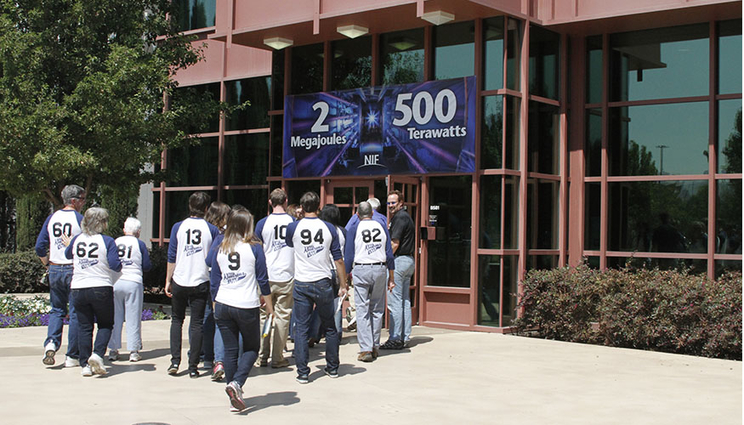'Route 66 to the Atomic West' class visits the Lab
"Route 66 to the Atomic West" is a class offered by the University of West Florida (UWF) in Pensacola, Fla. Taught by Patrick Moore, UWF public history program director, the class spends the month of July traveling from coast to coast engaging in presentations, tours, site visits and other activities. The self-proclaimed "Free Neutrons" travel 6,800 miles in four mini-vans visiting 16 atomic/Cold War sites and 12 national parks and monuments.
They recently visited Lawrence Livermore National Laboratory (LLNL) -- stop number 14 on their journey -- in matching jerseys, resembling a baseball team. George Beck, Carrie Martin, Diane Nelson and Nick Williams of the Lab's Public Affairs Office escorted the group. Their day included a lesson on Livermorium, given by Mark Stoyer; tours of the Discovery Center, the Center for Accelerator Mass Spectrometry (CAMS) and the National Ignition Facility (NIF); and a presentation of the Lab's popular " Fun with Science " program.
"This tour at LLNL has definitely been the highlight of the trip. So far, it's been my favorite," student Martha Tye said. "The National Ignition Facility was probably the coolest thing for me, because I got to learn it's not only about the stockpile initiative, but it's also going to try and help create a clean source of power, which I thought was very interesting."
Prior to starting their journey, the students engage in lectures, discussion and exercises and complete a series of comprehensive readings and topical research assignments. Once they depart Pensacola, the students then photograph, record and document their findings and experiences. Students are assigned to cover locations along the way and are tasked to create podcasts about their trip and insights on the atomic west into the Next Exit History (TM) system (website and app).
"One thing is certain; this isn't just a vacation," Moore said. "The students do extensive background research on the sites we visit. It's exhausting for them, but they get an awful lot out of it."
Moore started this program in 2001 to provide his students an "opportunity to learn about the atomic west in a different perspective." In the beginning, LLNL was not on their tour route. Moore soon realized he was doing a disservice to his students because "LLNL is an essential stop on the tour. The science that comes out of LLNL has really emerged over the last 50 years."
"The Lawrence Livermore National Laboratory and those that spoke with us have inspired me to major in science once more. The work they do benefits mankind. The men and women that work at the Lab are my heroes and greatest inspiration" said Kirsten Holley on the Route 66 to the Atomic West's Facebook page .
In addition to LLNL, they also visited the Los Alamos National Laboratory (LANL) and the Nevada National Security Site (NNSS), formerly the Nevada Test Site (NTS). Moore was joined on this trip by two very special students: his parents, Joan and Michael Moore. Moore's father Michael, now retired, was a physicist and group leader at LANL and spent a good portion of his career commuting to NTS (more than 70 visits). They both said that this trip has been the "experience of a lifetime."
"The national laboratories that we have in this nation have really helped make this country great, and will continue to do so in the future," student Dane Sherrets said. "I think they are going to continue to be really important in terms of providing for our security, helping us to become energy independent, and even just charting out what we want to do in space and other future endeavors."
As a history major, Sherrets didn't have a strong background in science; however, Moore prepared them for the scientific terminology they would be immersed in. "Visiting these different sites has given me a whole new respect for physicists and chemists and being able to see it first-hand has actually helped me to understand it much better," he said.
"The goal of this experiential learning opportunity is that students will develop not only an understanding for the topic material, but also develop a respect for other people, environments and social behaviors through the courses' multicultural and interdisciplinary approaches," Moore said. "It's important to get out of the classroom and do something with history outside of the academic world."
Moore rotates the "Route 66 to the Atomic West" trip with two other programs; "Lewis and Clark, Corps of Discovery," which follows in the footsteps of Meriwether Lewis, William Clark and the rest of the original Corps more than 200 years ago, and, "Civil Liberties to Civil Rights: The Great Urban American Adventure," which provides students with an in-depth understanding of how, in the northeastern, midwestern, and southern cities, Americans fought for and won their freedom, ranging from colonial rule to the 20th century. "If you were to take all three courses over three years, you would get to see 47 out of the 48 states in the continental U.S.," Moore said. "The only state not visited is Wisconsin."
Student Jamie Gray said, "I will always remember the people I met along the way. One thing I have had a sense of this whole time is that we are doing something that so many other people will never do, will never see, will never take advantage of, and that is really powerful. This has been a mix-mash of experiences that are very rare for people to get." Tye added: "This trip has allowed me the opportunity to gain a different perspective about history, about what's going on right now, and the way that science is used for the betterment of society." Because of Moore's passion and dedication to public history and experiential learning, he was elected as president of the National Council on Public History and begins his two-year term in 2014.
For more information, visit the Next Exit History Web page and/or follow Route 66 to the Atomic West on Facebook.
See the video .
Contact
Carenda L Martin[email protected]
925-424-4175
Related Links
Next Exit History Web pageVideo
Related Files
DownloadTags
Lasers and Optical S&TLasers
National Ignition Facility and Photon Science
Strategic Deterrence
Community Outreach
Visiting
Featured Articles









